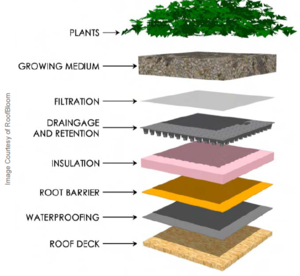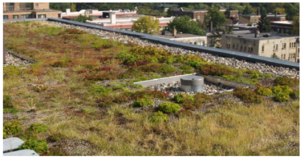
MS4 fact sheet - Green Roofs
Green roofs are becoming commonly accepted and installed across the Upper Midwest on buildings of all shapes and sizes. Green roofs are being utilized as a means to reduce costs associated with the life-cycle of conventional roofs, and heating and cooling. In addition, they are being used to address stormwater management and large green roofs are being used to create spaces for public benefit in urban settings.
This fact sheet focuses on the benefits of green roofs and provides examples of municipal programs and resolutions for municipal buildings.
Contents
Benefits and pollution reduction
Green roofs offer several benefits such as reduced runoff, increased evapotranspiration, prolonged roof life, reduced roof temperature, decreased energy costs, reduction of the urban heat island, habitat for birds and insects, carbon sequestration, improved air quality, and enjoyment and increased productivity for adjacent building occupants. Green roofs also have aesthetic qualities which help to meet landscaping requirements, and they create additional living space if constructed properly. The possibilities of so many benefits, particularly in urban high-density environments such as downtown Minneapolis and St. Paul, have triggered the use of green roofs.
Program development and implementation
Types of green roofs
A green roof typically consists of the following components listed from the bottom upward: roof deck; a waterproof membrane to protect the building from leaks; a root barrier to prevent roots from penetrating the waterproof membrane; an insulation layer; a drainage layer, usually made of lightweight gravel or plastic; a geotextile or filter mat that allows water to soak through but prevents erosion of fine soil particles; a growing medium; plants; and, sometimes, an erosion control blanket.
There are two general types of green roofs: extensive and intensive. Structural load capacity, that is, how much weight the roof can hold, is a significant factor in determining whether an extensive or intensive green roof should be considered from a design and liability standpoint.
- Extensive green roofs Comprise a lower-maintenance design with groundcover in shallow soil, which in relationship to an intensive green roof adds significantly less (14 to 35 pounds per square foot) to the roof’s dead load (Dunnett and Kingsbury, 2008). This roof type is covered in engineered soil medium that is 70 to 90 percent inorganic and generally 3 to 6 inches deep. Extensive green roofs support a limited palette of vegetation that is generally low-lying and designed for maximum groundcover, water retention, transpiration, and erosion protection. An extensive green roof is generally much less expensive to construct than an intensive green roof and requires less maintenance. Maintenance on extensive green roofs is usually performed in bulk – similar to a lawn. Extensive green roofs are generally designed to support limited traffic for building and green roof maintenance.
- Intensive green roofs These are garden-like installations with deeper, more organic soils that can potentially support more diverse plantings. Intensive green roofs can increase dead loads from 59 to 199 pounds per square foot (Dunnett and Kingsbury, 2008). The range of plantings is dependent on a combination of the soil type and depth, as well as the maintenance availability – including watering and fertilization. Native plants and several traditional garden plants are available in the planting palette as the depth and organic content of the soil medium is increased. In several cases intensive green roofs are designed to support pedestrian traffic because of their higher structural load capacity. They typically require more intense maintenance, such as irrigation and fertilization. Intensive green roof maintenance is generally more specific – similar to a garden. Intensive green roofs often cover underground parking decks, such as the installation in Minneapolis at Brit’s Pub.
Example incentives and initiatives
- City of Minneapolis. One of the many green initiatives being taken on by the City of Minneapolis is promoting green roofs. Minneapolis has set the goal of completing 150 green roofs around the city by the year 2015. Currently the city has 39 green roofs in place through the collaboration with local businesses, organizations, and other government agencies. In 2008, the city finished the over 5,000 square foot green roof a top the Minneapolis City Hall and Courthouse.
- City of Chicago – Green Roof & Cool Roof Grants Programs. In 2005, the City of Chicago launched its green roofs grant program, offering twenty 💲5,000 grants to residents and small businesses to help finance planning and installation. In 2006, forty 💲5,000 grants were awarded. Nearing the end of 2006, there were more than 250 public and private green roofs totaling more than 1 million square feet that are under design or construction in Chicago, a true testament to the efficacy of the grant program.
- City of Toronto – Green Roof Bylaw & Eco-Roof Incentive Program. In May of 2009, Toronto became the first city in North America to adopt a bylaw to require and govern the construction of green roofs on new development. The bylaw will apply to all new building permit applications made after January 31, 2010 (residential, commercial and institutional) and January 31, 2011 for all new industrial development. The new bylaw will be required on all new development above 2,000 square meters of gross floor area and have a graduated coverage requirement ranging from 20 to 60 percent.
- Toronto’s Eco-Roof Incentive Program. The scope of polices now available in Toronto to encourage green roof implementation include: 1) Incentives through the Green Roof Incentive Pilot Program with a 💲200,000 budget for the first year (2009) providing a 💲10 per square foot. financial incentive up to a maximum of 💲20,000 per project, and 2) green procurement by government facilities requiring that green roofs be installed on new City owned buildings and on retrofit projects where feasible.
- City of Seattle – The Green Factor. The Green Factor is a landscape requirement designed to increase the quantity and quality of planted areas in Seattle while allowing flexibility for developers and designers to meet development standards. Permit applicants in affected zones must demonstrate that their projects meet the Green Factor by using the Green Factor Score Sheet. The scoring system is designed to encourage larger plants, permeable paving, green roofs, vegetated walls, preservation of existing trees, and layering of vegetation along streets and other areas visible to the public.
Maintenance considerations
Once a properly installed green roof is well established, maintenance requirements are usually minimal. However, of the two basic types of green roofing systems, extensive and intensive, the latter requires more maintenance due to the increased organic material in the soil (more weeds), ongoing irrigation and/ or fertilization of vegetation, and increased human traffic and activities. Maintenance considerations for both systems include inspection of the roof membrane, the most crucial element of a green roof, as well as routine inspection and as needed maintenance of the drainage layer flow paths.
Regardless, for any kind of green roof, initial watering and occasional fertilization are required until the plants have fully established themselves. Supplemental irrigation in addition to natural precipitation at least once a week is most likely required during the vegetation establishment period. Ongoing irrigation will be required for intensive green roofs, and will be needed during prolonged dry periods for intensive and extensive green roofs. In addition, maintenance activities should include hand pulling weedy species every growing season.
Because of the nature of rooftop installations, a certain number of green roof plants can be expected to die-off. This number will be higher in initial roof establishment, but will decrease as the plants become established. It is critical that the dead plants be replaced to regain the design plant coverage.
Typical cost
Cost data indicates that green roof pricing varies from 💲8 per square foot to 💲28 per square foot for eight-inch extensive roof systems. Most cost references quote 💲10 to 💲12 per square foot (Chicago Department of Planning and Development). These costs include all aspects of green roof development, from the waterproofing membrane to soil substrate creation to planting. By far the highest costs associated with green roof creation are the soil substrate/growth medium and the plant components associated with it.
While a green roof may cost 2 to 3 times that of a conventional roof, life expectancy is commonly estimated to be at least twice as long. In addition, when evaluating the cost effectiveness of green roofs, all related cost reductions should be tabulated. For example, these could include the reduced energy costs of the building under the roof, the runoff credits possible through local regulatory programs and the carbon sequestration that could be credited as part of local CO2 monitoring.
This page was last edited on 23 January 2023, at 23:22.


